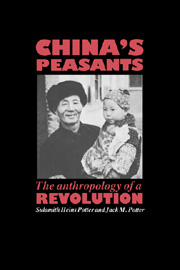Book contents
- Frontmatter
- Contents
- List of illustrations
- List of tables
- Preface
- Notes on the text
- Map 1 China
- 1 The old “feudal” order: Zengbu before Liberation
- 2 Establishing the new order
- 3 The ordeal of collectivization
- 4 The Cultural Revolution
- 5 Maoist society: the production team
- 6 Maoist society: the brigade
- 7 Maoist society: the commune
- 8 Impatient aspirations: transition to the post-Mao period
- 9 The cultural construction of emotion in rural Chinese social life
- 10 Marriage, household, and family form
- 11 Chinese birth planning: a cultural account
- 12 Lineage and collective: structure and praxis
- 13 Party organization
- 14 The party ethic: a devotion born of distress and enthusiasm
- 15 A caste-like system of social stratification: the position of peasants in modern China's social order
- 16 The Chinese peasants and the world capitalist system
- 17 The crystallization of post-Mao society: Zengbu in 1985
- References
- Index
3 - The ordeal of collectivization
Published online by Cambridge University Press: 02 December 2009
- Frontmatter
- Contents
- List of illustrations
- List of tables
- Preface
- Notes on the text
- Map 1 China
- 1 The old “feudal” order: Zengbu before Liberation
- 2 Establishing the new order
- 3 The ordeal of collectivization
- 4 The Cultural Revolution
- 5 Maoist society: the production team
- 6 Maoist society: the brigade
- 7 Maoist society: the commune
- 8 Impatient aspirations: transition to the post-Mao period
- 9 The cultural construction of emotion in rural Chinese social life
- 10 Marriage, household, and family form
- 11 Chinese birth planning: a cultural account
- 12 Lineage and collective: structure and praxis
- 13 Party organization
- 14 The party ethic: a devotion born of distress and enthusiasm
- 15 A caste-like system of social stratification: the position of peasants in modern China's social order
- 16 The Chinese peasants and the world capitalist system
- 17 The crystallization of post-Mao society: Zengbu in 1985
- References
- Index
Summary
Land reform had created a new poor and lower-middle peasant economy and society, which gave most peasants a basic means of livelihood, and certainly secured peasant support for the new government. But it was not a final solution to Zengbu's agrarian problems. If land reform were implemented merely as a clean start for private ownership, and if private ownership as an institution were allowed to continue, within one generation there would be a re-emergence of economic inequality, with rich peasants at the top of the rural economic class structure, and poor and landless peasants at the bottom, depending on the differential economic success of each family. And success would not necessarily be the result of competence: demographic variation alone would produce a re-emergence of classes, since some families would have to divide their small allotment of land among six sons, turning all of them into poor peasants in the second generation, while others would leave all their land to an only son, making him automatically a rich peasant.
At the higher levels of the Chinese government – “higher levels” being the term the peasants use to refer to the bureaucratic echelons rising above them – there began a debate over agricultural policy which has continued up to the present. Some more orthodox Marxists believed that the attainment of a collectivist socialist or communist society in rural China would not be possible until the technological and economic base was developed and modernized.
- Type
- Chapter
- Information
- China's PeasantsThe Anthropology of a Revolution, pp. 59 - 82Publisher: Cambridge University PressPrint publication year: 1990



